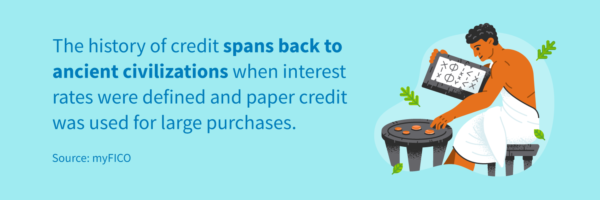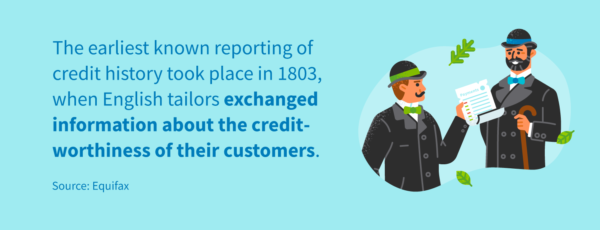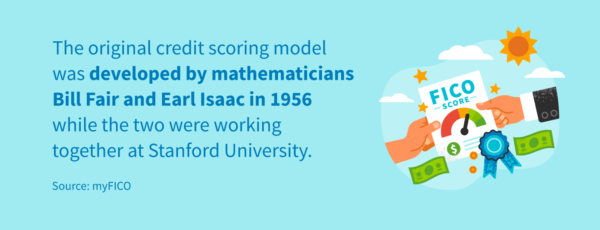
Disclosure regarding our editorial content standards.
Credit scores as we know them today were invented in 1989, when the FICO® Score debuted. Created by Bill Fair and Earl Isaac, the credit scoring system known as FICO (named after the Fair Isaac Corporation) helped simplify the many variables present in a person’s credit history.
A person’s credit history can be long and complicated, so weaving all of that information into a simple three-digit score made life easier for lenders. But the journey to create credit scores spans back at least a hundred years—and you could even argue that credit scores wouldn’t be around today if it weren’t for ancient civilizations that used credit thousands of years ago.
Read on to learn about the origins of credit, how credit reporting began and where credit scores came from.
Early civilizations: the origins of credit
While credit scores are a recent development, credit itself has a very long history. Ancient civilizations like Sumer, Babylon and the Roman Empire used credit in various forms. Hammurabi, for example, defined legal limits of interest rates, and Cicero writes about land purchases that were made using credit that was tracked on parchment.

It’s likely that not everyone had access to credit—instead, credit was probably based on reputation and status. As a result, merchants could use credit to expand their businesses. Later, explorers would use credit to fund their voyages: building ships and hiring a crew with the promise to return the capital with interest after a lucrative journey.
During these early days of credit, debates were frequently held about the fairness of high interest rates. Credit and interest often enabled risky but potentially profitable businesses to get off the ground, but interest could also sink people who had simply taken on too much risk. And credit was difficult for lenders, too. There wasn’t a great way to keep track of any one person’s credit history, so lending money was a risky proposition.
Soon, though, a small group of people would begin keeping track—changing the credit landscape forever.
1800s and early 1900s: credit reporting begins
Before credit scores could be developed, people needed to start keeping track of consumer credit behavior. While we now use computer databases to record financial information provided by lenders, early credit reporting was largely done by word of mouth.

In 1803, a group of English tailors became the first known organization to monitor credit history by exchanging information on which customers paid back their debts. Many other groups soon followed this same practice, but it was easy for debtors to slip from one merchant to another since no standardized system existed.
Over time, larger credit reporting groups emerged. For example, the Manchester Guardian Society published a newsletter detailing the negligent credit behavior of locals. Credit reporting quickly migrated from England to the United States, where groups like R.G. Dun and Co. and the Retail Credit Company operated with millions of index cards to keep notes on credit activity throughout the country.
Retailers across the United States began offering greater access to credit to consumers now that merchants could make more educated guesses about who was likely to pay down the road. Unfortunately, this system was rarely fair or efficient, since it relied on subject judgments rather than a systematic analysis of credit history.
Armed with data and the desire for a more comprehensive way to evaluate credit, a pair working at Stanford University would soon formulate the beginnings of a new concept: the credit score.
1950s to today: the birth and evolution of credit scores
A credit score is a straightforward number, but producing it involves balancing a variety of factors, like how much credit someone has available and how often they make payments on their debts. In 1956, Bill Fair and Earl Isaac created the world’s first credit scoring system—but it took a while for the idea to catch on with large financial companies.
Finally, in 1989, Fair and Isaac released the FICO Score, an updated version of their model that is now used by lenders all across the country. The three-digit score that we all know is the product of Fair and Isaac’s scoring models, which take someone’s credit history and translate it to a score that correlates with risk: the higher a person’s score, the less risky it is to lend money to them.

As we know from our history lesson above, scoring wouldn’t be possible at all without information about consumer credit behavior. That’s why three credit bureaus—TransUnion®, Experian® and Equifax®—work with lenders to keep track of the credit histories of millions of people. In fact, one of these companies, Equifax®, was originally the Retail Credit Company, formed in 1899 before credit scores were ever invented.
Even since credit scores were invented, a lot has changed—and the industry is still constantly evolving.
The future of credit scores
In the more than 30 years since credit scores were invented, they have gone through changes. The FICO® model is regularly updated to account for new or different factors. Meanwhile, the three credit bureaus have created their own scoring model, called VantageScore, which some lenders also use to make decisions about individual borrowers.
In recent years, an increasing number of lenders have developed in-house algorithms for determining creditworthiness. Sometimes FICO scores continue to factor in, while in other cases lenders are simply weighing factors directly from your credit report.
Additionally, many lenders and some credit bureaus are now allowing nontraditional lines of credit—like rent or phone bills—to factor into credit scores. This practice opens up credit to many groups of people who may otherwise be invisible to the credit system, preventing access.
Regardless of the history of credit scores, one thing is clear: if you want to borrow money for any reason—like buying a house or a car—managing your available credit and keeping an eye on your credit report is important.
What do credit scores mean for you?
Throughout the entire history of credit we described above, the same truth holds: when you need to borrow money for any reason, you need people to believe you’ll pay them back. Your credit score is one of the factors a lender will use when deciding whether to offer you a loan, mortgage or credit card.
Fortunately, your credit score is entirely within your control—and it is based only on your credit choices. Credit scoring models don’t include information about your income, education level, personal background, marital status or geographic location. Instead, your credit score reflects your accounts (like loans and credit cards), balances, payment history, length of credit history and how often you apply for new credit.
To get a sense of where your score comes from, the best first step is to get a copy of your credit report from all three credit bureaus. Take a moment to scan over your report, noticing the accounts and balances that are reported.
Most importantly, take note of any accounts you don’t recognize, as they could be fraudulent or inaccurate. In that case, you may want to seek out the support of a credit repair company, which can assist you in disputing the inaccurate information from your report. Removing inaccurate information—and improving your credit habits—will likely help your score go up over time. That way, you’ll be ready no matter what the future of credit scores looks like.
Note: The information provided on CreditRepair.com does not, and is not intended to, act as legal, financial or credit advice; instead, it is for general informational purposes only.
Questions about credit repair?
Chat with an expert: 1-800-255-0263






